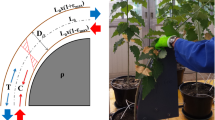Abstract.
Tissue stresses, which occur in turgid herbaceous stems, both elongating and non-elongating, and tree growth stresses (TGSs) which occur in woody stems, are similar in that (i) they form self-equilibrating patterns of stresses (tensile and compressive) in stems, and (ii) the asymmetric, graviresponsive change in the pattern tends to bend the stem. The longitudinal tensile tissue stress (TS) which occurs in the outer layers of turgid stems is a few times higher than the osmotic pressure of cell sap in such a layer. Usually it is considered that TSs originate from the differential growth of tissues in a stem; however, physical analysis of a turgid stem model has shown that TSs are an unavoidable physical consequence of the variation in structural characteristics of cell layers or vascular strands in turgid stems. The model applied to the sunflower hypocotyl gives forces which fit well to those measured. The structural characteristics are sufficient to explain fully the TSs which exist in turgid stems. Differential growth is not necessary in this respect. Examination of the model shows also that the longitudinal elastic strain of all cell walls in a turgid stem is the same at a given stem level regardless of wall thickness, i.e. the structure-based TSs compensate for the variation in turgor-induced wall stress in single cells with variable diameter and wall thickness. The importance of this compensation for the anisotropy of wall stresses is presented. The forces which generate TSs exert bending moments which are high but they sum mutually to zero in a vertical stem. In gravistimulated turgid stems of Reynoutria, the TSs decrease considerably on the lower side while those on the upper side remain unaltered. The consequences of this asymmetric change for gravitropic bending are analysed.
Tree growth stresses arise in a process by which new cells added by the cambium to the secondary xylem tend to shrink longitudinally (except compression wood) during maturation of the cell walls. The pattern of TGSs is characterized by tensile or compressive stress in the peripheral or the core wood, respectively. An asymmetrical pattern of TGSs due to asymmetrical deposition of wood results in a bending moment which equilibrates the bending moment caused by the weight of a lateral branch. In response to a gravity-derived stimulus the TGS pattern may be modified by asymmetric formation of reaction wood which differs histologically from normal wood: tension wood in many arborescent angiosperms, and compression wood in conifers. The formation and functioning of the reaction wood is discussed.
Similar content being viewed by others
Author information
Authors and Affiliations
Additional information
Received: 27 June 1996?/?Accepted: 8 April 1997
Rights and permissions
About this article
Cite this article
Hejnowicz, Z. Graviresponses in herbs and trees: a major role for the redistribution of tissue and growth stresses. Planta 203 (Suppl 1), S136–S146 (1997). https://doi.org/10.1007/PL00008102
Issue Date:
DOI: https://doi.org/10.1007/PL00008102




